北师大无机化学四版习题答案14章碳硅硼
- 格式:doc
- 大小:671.50 KB
- 文档页数:9
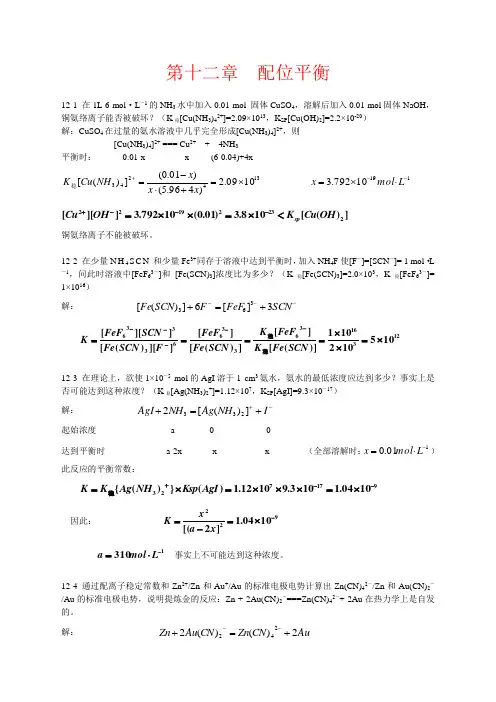
第十二章 配位平衡12-1 在1L 6 mol ·L -1的NH 3水中加入0.01 mol 固体CuSO 4,溶解后加入0.01 mol 固体NaOH ,铜氨络离子能否被破坏?(K 稳[Cu(NH 3)42+]=2.09×1013,K SP [Cu(OH)2]=2.2×10-20) 解:CuSO 4在过量的氨水溶液中几乎完全形成[Cu(NH 3)4]2+,则[Cu(NH 3)4]2+ === Cu 2+ + 4NH 3平衡时: 0.01-x x (6-0.04)+4x1342431009.2)496.5()01.0(])([⨯=+⋅-=+x x x NH Cu K 稳 11910792.3--⋅⨯=L mol x ])([108.3)01.0(10792.3]][[22321922OH Cu K OH Cu sp <⨯=⨯⨯=---+铜氨络离子不能被破坏。
12-2 在少量N H 4S C N 和少量Fe 3+同存于溶液中达到平衡时,加入NH 4F 使[F -]=[SCN -]= 1 mol ·L-1,问此时溶液中[FeF 63-]和 [Fe(SCN)3]浓度比为多少?(K 稳[Fe(SCN)3]=2.0×103,K 稳[FeF 63-]= 1×1016)解: ---+=+SCN FeF F SCN Fe 3][6])([363 123163633663336105102101)]([][])([][]][)([]][[⨯=⨯⨯====-----SCN Fe K FeF K SCN Fe FeF F SCN Fe SCN FeF K 稳稳12-3 在理论上,欲使1×10-5 mol 的AgI 溶于1 cm 3氨水,氨水的最低浓度应达到多少?事实上是否可能达到这种浓度?(K 稳[Ag(NH 3)2+]=1.12×107,K SP [AgI]=9.3×10-17)解: -++=+I NH Ag NH AgI ])([2233起始浓度 a 0 0达到平衡时 a-2x x x (全部溶解时:101.0-⋅=L mol x )此反应的平衡常数:9177231004.1103.91012.1)(})({--+⨯=⨯⨯⨯=⨯=AgI Ksp NH Ag K K 稳因此: 9221004.1]2[(-⨯=-=x a x K 1310-⋅=L mol a 事实上不可能达到这种浓度。
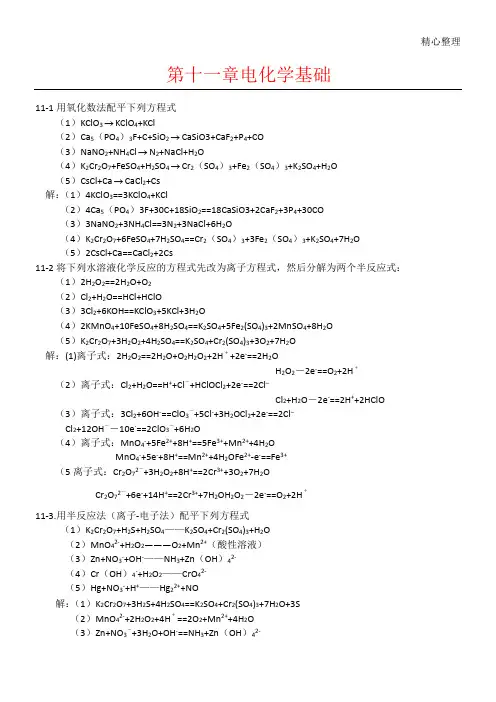
精心整理第十一章电化学基础11-1用氧化数法配平下列方程式(1)KClO 3→KClO 4+KCl(2)Ca 5(PO 4)3F+C+SiO 2→CaSiO3+CaF 2+P 4+CO(3)NaNO 2+NH 4Cl →N 2+NaCl+H 2O(4)K 2Cr 2O 7+FeSO 4+H 2SO 4→Cr 2(SO 4)3+Fe 2(SO 4)3+K 2SO 4+H 2O(5)CsCl+Ca →CaCl 2+Cs解:(((((11-2(1(2(3(4(5解:(2(3(4(511-3.用半反应法(离子-电子法)配平下列方程式(1)K 2Cr 2O 7+H 2S+H 2SO 4——K 2SO 4+Cr 2(SO 4)3+H 2O(2)MnO 42-+H 2O 2———O 2+Mn 2+(酸性溶液)(3)Zn+NO 3-+OH -——NH 3+Zn (OH )42-(4)Cr (OH )4-+H 2O 2——CrO 42-(5)Hg+NO 3-+H +——Hg 22++NO解:(1)K 2Cr 2O 7+3H 2S+4H 2SO 4==K 2SO 4+Cr 2(SO 4)3+7H 2O+3S(2)MnO 42-+2H 2O 2+4H +==2O 2+Mn 2++4H 2O(3)Zn+NO 3-+3H 2O+OH -==NH 3+Zn (OH )42-(4)2Cr(OH)4-+3H2O2+2OH==-2CrO42-+8H2O(5)6Hg+2NO3-+8H+==3Hg22++2NO+4H2O11-4将下列反应设计成原电池,用标准电极电势判断标准态下电池的正极和负极,电子传递的方向,正极和负极的电极反应,电池的电动势,写出电池符号.(1)Zn+2Ag+=Zn2++2Ag(2)2Fe3++Fe=3Fe2+(3)Zn+2H+=Zn2++H2(4)H2+Cl2=2HCl(5)3I2+6KOH=KIO3+5KI+3H2O11-5写出下列各对半反应组成的原电池的电池反应、电池符号,并计算标准电动势。
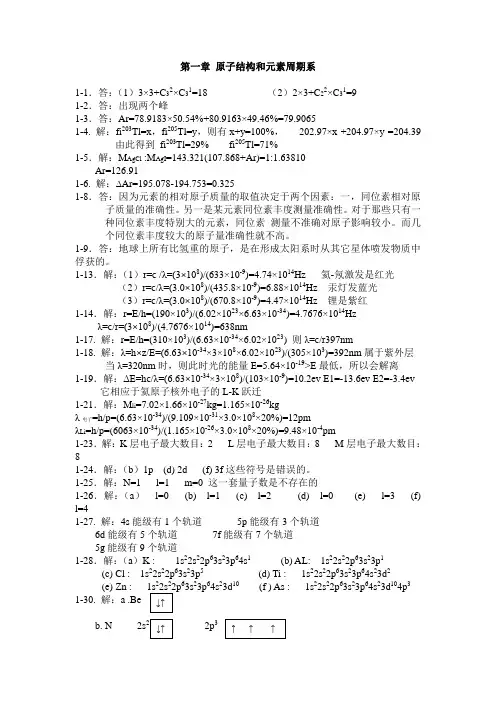

第一章物质的结构1-1 在自然界中氢有三种同位素,氧也有三种同位素,问:总共有种含不同核素的水分子?由于3H太少,可以忽略不计,问:不计3H时天然水中共有多少种同位素异构水分子?1-2 天然氟是单核素(19F)元素,而天然碳有两种稳定同位素(12C和13C),在质谱仪中,每一质量数的微粒出现一个峰,氢预言在质谱仪中能出现几个相应于CF4+的峰?1-3 用质谱仪测得溴得两种天然同位素的相对原子质量和同位素丰度分别为79Br 789183占50。
54%,81Br 80。
9163占49。
46%,求溴的相对原子质量(原子量)。
1-4 铊的天然同位素203Tl和205Tl的核素质量分别为202。
97u和204。
97u,已知铊的相对原子质量(原子量)为204。
39,求铊的同位素丰度。
1-5 等质量的银制成氯化银和碘化银,测得质量比m(AgCl):m(AgBr)=1。
63810:1,又测得银和氯得相对原子质量(原子量)分别为107。
868和35。
453,求碘得相对原子质量(原子量)。
1-6 表1-1中贝采里乌斯1826年测得的铂原子量与现代测定的铂的相对原子质量(原子量)相比,有多大差别?1-7 设全球有50亿人,设每人每秒数2个金原子,需要多少年全球的人才能数完1mol金原子(1年按365天计)?1-8 试讨论,为什么有的元素的相对质量(原子量)的有效数字的位数多达9位,而有的元素的相对原子质量(原子量)的有效数字却少至3~4位?1-9 太阳系,例如地球,存在周期表所有稳定元素,而太阳却只开始发生氢燃烧,该核反应的产物只有氢,应怎样理解这个事实?1-10 中国古代哲学家认为,宇宙万物起源于一种叫“元气”的物质,“元气生阴阳,阴阳生万物”,请对比元素诞生说与这种古代哲学。
1-11 “金木水火土”是中国古代的元素论,至今仍有许多人对它们的“相生相克”深信不疑。
与化学元素论相比,它出发点最致命的错误是什么?1-12 请用计算机编一个小程序,按1.3式计算氢光谱各谱系的谱线的波长(本练习为开放式习题,并不需要所有学生都会做)。
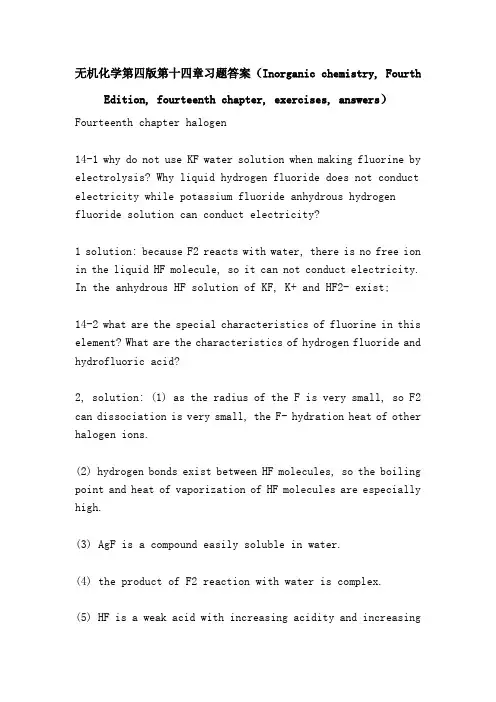
无机化学第四版第十四章习题答案(Inorganic chemistry, Fourth Edition, fourteenth chapter, exercises, answers)Fourteenth chapter halogen14-1 why do not use KF water solution when making fluorine by electrolysis? Why liquid hydrogen fluoride does not conduct electricity while potassium fluoride anhydrous hydrogen fluoride solution can conduct electricity?1 solution: because F2 reacts with water, there is no free ion in the liquid HF molecule, so it can not conduct electricity. In the anhydrous HF solution of KF, K+ and HF2- exist;14-2 what are the special characteristics of fluorine in this element? What are the characteristics of hydrogen fluoride and hydrofluoric acid?2, solution: (1) as the radius of the F is very small, so F2 can dissociation is very small, the F- hydration heat of other halogen ions.(2) hydrogen bonds exist between HF molecules, so the boiling point and heat of vaporization of HF molecules are especially high.(3) AgF is a compound easily soluble in water.(4) the product of F2 reaction with water is complex.(5) HF is a weak acid with increasing acidity and increasingconcentration.(6) HF can react with SiO2 or silicate to form gaseous SiF4;14-3 (1) the reaction tendency of Cl2 was generated by comparing KMnO4, K2Cr2O7 and MnO2 with hydrochloric acid (1mol.L-1) according to the electrode potential.(2) what is the minimum concentration of hydrochloric acid if MnO2 is reacted with hydrochloric acid to cause Cl2 to occur successfully?3, Xie: (1) according to the relationship between electrode potential, we can see the reaction trend:KMnO4>K2Cr2O7>MnO2;14-4 according to the potential map, the reaction equilibrium constant of Br2 in alkaline aqueous solution is reduced to Br- and BrO3- at 298K.4. Solution: by formula: -ZFE=-RTlnKGet: K=exp (ZFE/RT)=2.92 * 103814-5, three, fluorinated nitrogen NF3 (boiling point -129 degrees Celsius) does not show Lewis alkaline, and relatively low molecular mass compounds NH3 (boiling point -33 degrees Celsius) is a well known Lewis base. (a) to explain the reasonwhy their volatility is so great; (b) explain why they differ in alkalinity.5. Xie: (1) NH3 has a higher boiling point because of the hydrogen bond between the molecules.(2) the NF3 atom has a large radius of F atoms, which makes it difficult to match Lewis acid because of steric hindrance.In addition, the electronegativity of the F atom is larger, which weakens the electronegativity of the central atom N.14-6 from bittern making Br2 available chlorine oxidation method. But from a thermodynamic point of view, Br- can be oxidized to Br2 by O2. Why not use O2 to make Br2?14-7 pass Cl2 can be used in slaked lime to obtain bleaching powder, and hydrochloric acid can be added to Cl2 in the solution of bleaching powder. The two phenomena are explained by using electrode potential.7, Xie: because Cl2 pass into the hydrated lime is in alkaline medium, and because of, so Cl2 in alkaline conditions prone to disproportionation reaction.When the hydrochloric acid is added to the bleach solution, the following reaction can be carried to the right:HClO + Cl- + H+ = Cl2 + H2O14-8 which of the following oxides are anhydrides: OF2, Cl2O7,ClO2, Cl2O, Br2O and I2O5? If the anhydride is prepared, the reaction is obtained by the corresponding acid or other method of getting the anhydride.8 solution: Cl2O7 is the anhydride of HClO4. Cl2O, Br2O are HClO, HBrO anhydrides, respectively14-9 how do you identify the three salts of KClO, KClO3, and KClO4?9 、 solution: add a small amount of solid into the dried test tube, and then do the following experimentAdd dilute hydrochloric acid, that is, Cl2 gas release is KClO;KClO+2HCl=KCl+Cl2+H2OAdding concentrated hydrochloric acid has Cl2 and emits, and the solution turns yellow is KClO3;8KC1O3+24HCl (strong) =9Cl2 = +8KCl+60ClO2 (yellow) +12H2OThe other is KClO414-10 the reaction equation for preparing HIO4, KIO3, I2O5 and KIO4 was prepared with I2 as raw material.The solubility of 14-11 (1) I2 in water is very small. The concentration of I2 saturated solution is calculated from the following 2.5 reactions at 298K.I2 (s) + 2e- = 2I-; 0.535V = Phi thetaI2 (AQ) + 2e- = 2I-; 0.621V = Phi theta(2) 0.100mol I2 was dissolved in 1.00L 0.100mol.L-1 KI solution and I3- solution was obtained. The Kc value of the I3- generation reaction is 0.752, and the concentration of I2 in the I3- solution is calculated.14-11, (1) I2 (AQ) =I2 (s)K=exp (ZFE/RT)=812K=1/[I2 (AQ)]I2 (AQ) =1/812=0.00123mol/L(2) I2+I-=I3-;KC=; so [I2]=?The solution is x=0.0934mol/L.Explain the following phenomena: 14-12 by adding a small amount of NaClO in the electrode potential of starch potassium iodide solution, blue A solution, adding excessive NaClO, B get a colorless solution, then acidified and add a small amount of solid Na2SO3 in B solution, A blue reproduction, when the excessive amount of Na2SO3 blue and then faded become colorlesssolution C, A the solution then add NaIO3 solution and blue. Point out A, B, C why each kind of substance, and write out the reaction equation of each step.12, Xie: A:I2;B:NaIO3;C:NaI14-13 write out the equation for the reaction of iodate and excess H2O2, such as adding starch to the system. What do you see?13 solution: HIO3+3H2O2=3O2+HI+3H2O; if the starch is added to the system, the solution turns blue slowly and then fades.14-14 write out the molecular formula of three metal halides with covalent bonds, and explain the common properties of this type of halides.14 and Xie: (AlCl3) 2; (AlBr3) 2; (AlI3) 2; all molecules contain coordinate bonds14-15 what is a multi halide? What is the trend of the formation of Br3- and Cl3- ions in comparison with I3- ions?14-16 what are halogen compounds?(a) write ClF3, BrF3 and IF3 halogen halide complexes, central atom hybridization orbitals, molecular electronicconfigurations and molecular configurations.(b) is there any risk of explosion when the following compounds are exposed to BrF3? Explain why.SbF5; CH3OH; F2; S2Cl2(c) why are halogenated compounds often diamagnetic, covalent, and chemically active than halogen?14-17 laboratory has a calcium halide, soluble in water, try to use concentrated H2SO4 to determine the nature and name of this salt.17. Solution: different phenomena can be identified by the reaction of halide with concentrated sulfuric acid.14-18 please click the following example,The bromine, iodine, and halogen ions containing various conversion and transformation conditions as oxygen acid interaction diagram.。

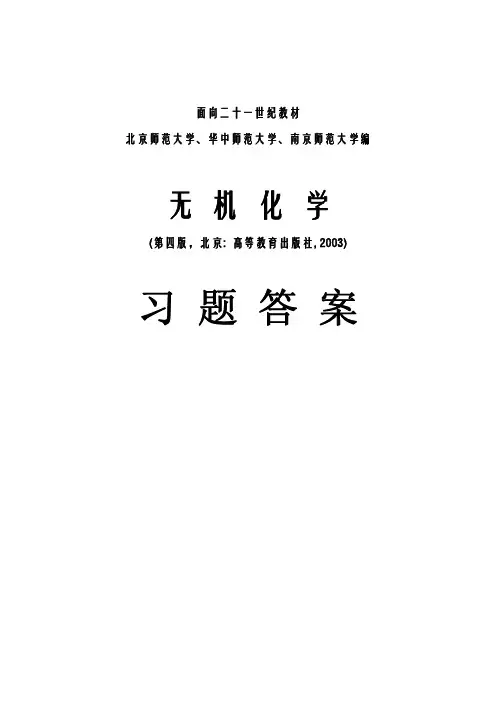
面向二十一世纪教材北京师范大学、华中师范大学、南京师范大学编无 机 化 学(第四版,北京: 高等教育出版社, 2003) 习 题 答 案第一章 原子结构和原子周期系1-1根据原子序数给出下列元素的基态原子的核外电子组态:(a)K (b)Al (c)Cl (d)Ti(Z=22) (e)Zn(Z=30) (f)As(Z=33) 答:(a)[Ar]4s1(b)[Ne]3s23p1(c)[Ne]3s23p5(d)[Ar]3d54s2(e)[Ar] 3d104s1(f)[Ar]4s24p31-2给出下列原子或离子的价电子层电子组态,并用方框图表示轨道,填入轨道的电子用箭头表示。
(a)Be (b)N (c)F (d)Cl- (e)Ne+ (f)Fe3+ (g)As3+1-3 Li+、Na+、K+、Rb+、Cs+的基态的最外层电子组态与次外层电子组态分别如何?1-4以下+3价离子那些具有8电子外壳?Al3+、Ga3+、Bi3+、Mn3+、Sc3+答:Al3+和Sc3+具有8电子外壳。
1-5已知电中性的基态原子的价电子层电子组态分别为:(a)3s23p5(b)3d64s2(c)5s2(d)4f96s2(e)5d106s1试根据这个信息确定它们在周期表中属于那个区、哪个族、哪个周期。
答:(a)p区,ⅦA族,第三周期 (b)d区,Ⅷ族,第四周期 (c)s区,ⅡA族,第五周期 (d)f区,ⅢB族,第六周期 (e)ds区,ⅠB族,第六周期1-6根据Ti、Ge、Ag、Rb、Ne在周期表中的位置,推出它们的基态原子的电子组态。
答:Ti位于第四周期ⅣB族,它的基态原子的电子组态为[Ar]3d24s2;Ge位于第四周期ⅣA族,它的基态原子的电子组态为[Ar]3d104s24p2;Ag位于第五周期ⅠB族,它的基态原子的电子组态为[Kr] 4d105s1;Rb位于第五周期ⅠA族,它的基态原子的电子组态为[Kr] 5s1;Ne位于第二周期0族,它的基态原子的电子组态为[He] 2s22p6。

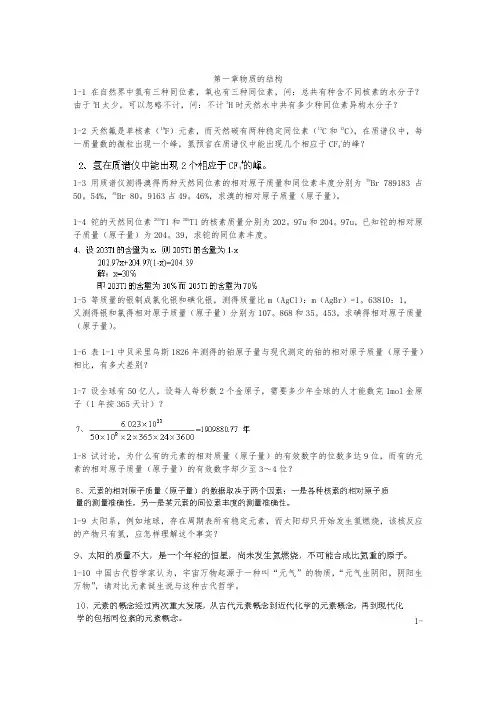
第一章物质的结构1-1 在自然界中氢有三种同位素,氧也有三种同位素,问:总共有种含不同核素的水分子?由于3H太少,可以忽略不计,问:不计3H时天然水中共有多少种同位素异构水分子?1-2 天然氟是单核素(19F)元素,而天然碳有两种稳定同位素(12C和13C),在质谱仪中,每一质量数的微粒出现一个峰,氢预言在质谱仪中能出现几个相应于CF4+的峰?1-3 用质谱仪测得溴得两种天然同位素的相对原子质量和同位素丰度分别为79Br 789183占50。
54%,81Br 80。
9163占49。
46%,求溴的相对原子质量(原子量)。
1-4 铊的天然同位素203Tl和205Tl的核素质量分别为202。
97u和204。
97u,已知铊的相对原子质量(原子量)为204。
39,求铊的同位素丰度。
1-5 等质量的银制成氯化银和碘化银,测得质量比m(AgCl):m(AgBr)=1。
63810:1,又测得银和氯得相对原子质量(原子量)分别为107。
868和35。
453,求碘得相对原子质量(原子量)。
1-6 表1-1中贝采里乌斯1826年测得的铂原子量与现代测定的铂的相对原子质量(原子量)相比,有多大差别?1-7 设全球有50亿人,设每人每秒数2个金原子,需要多少年全球的人才能数完1mol金原子(1年按365天计)?1-8 试讨论,为什么有的元素的相对质量(原子量)的有效数字的位数多达9位,而有的元素的相对原子质量(原子量)的有效数字却少至3~4位?1-9 太阳系,例如地球,存在周期表所有稳定元素,而太阳却只开始发生氢燃烧,该核反应的产物只有氢,应怎样理解这个事实?1-10 中国古代哲学家认为,宇宙万物起源于一种叫“元气”的物质,“元气生阴阳,阴阳生万物”,请对比元素诞生说与这种古代哲学。
1-11 “金木水火土”是中国古代的元素论,至今仍有许多人对它们的“相生相克”深信不疑。
与化学元素论相比,它出发点最致命的错误是什么?1-12 请用计算机编一个小程序,按1.3式计算氢光谱各谱系的谱线的波长(本练习为开放式习题,并不需要所有学生都会做)。

第14章 碳、硅、硼14.1. 对比等电子体CO 与N 2的分子结构及主要物理、化学性质。
解:CO 和N 2是等电子体(14e ),分子轨道能级图相似,分子中都有三重键:∶N ≡N ∶、C O δ+δ-∶∶,键能相近。
一般条件下,两种物质都是气体,很少溶于水;熔、沸点,临界压力,临界温度等一些物理性质也相似。
但CO 和N 2分子中三重键特点并不完全相同,N 2分子中负电荷分布是对称的,而CO 却是不对称的。
C 原子略带负电荷,再加上C 的电负性比N 小,因此CO 比N 2较易给出电子对向过渡金属原子(离子)配位,除形成σ―配键外,还有π―反馈键形成,故生成的配合物较稳定。
而N 2的配位能力远不如CO ,分子氮配合物远不如羰基化合物稳定。
所以CO 的键能虽比N 2略大,但化学性质却比N 2要活泼,不象N 2那样“惰性”。
14.2 概述CO 的实验室制法及收集方法,写出CO 与下列物质起反应的方程式并注明反应的条件:(1)Ni ;(2)CuCl ;(3)NaOH ;(4)H 2 ;(5)PdCl 2 解:CO 的实验室制法:HCOOH浓H 2SO 42O用排水集气法收集。
(1)Ni + 4CO100 -250atm 423 -493KNi(CO)4(2)(3)CO + NaOH HCOONa1.01×103kPa473K(4)CO + 3H 2CH 4 + H 2O Fe 、Co 、Ni523K,101kPa(5) CO + PdCl 2 + H 2O === Pd ↓ + CO 2 + 2HCl14.3. 某实验室备有CCl 4、干冰和泡沫灭火器(内为Al 2(SO 4)3和NaHCO 3),还有水源和砂。
若有下列失火情况,各宜用哪种方法灭火并说明理由: (1)金属镁着火; (2)金属钠着火;(3)黄磷着火; (4)油着火; (5)木器着火。
解:14.4. 标准状况时,CO 2的溶解度为170 mL / 100g 水:(1)计算在此条件下,溶液中H 2CO 3的实际浓度。
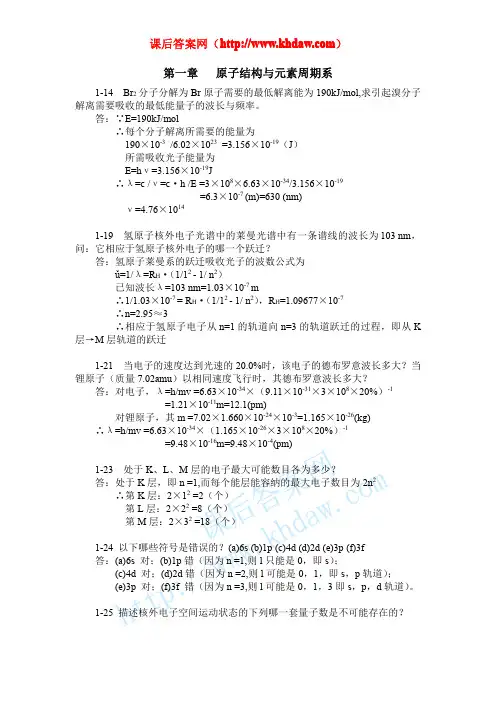
第一章原子结构与元素周期系1-14Br2分子分解为Br原子需要的最低解离能为190kJ/mol,求引起溴分子解离需要吸收的最低能量子的波长与频率。
答:∵E=190kJ/mol∴每个分子解离所需要的能量为190×10-3/6.02×1023=3.156×10-19(J)所需吸收光子能量为E=hν=3.156×10-19J∴λ=c/ν=c·h/E=3×108×6.63×10-34/3.156×10-19=6.3×10-7(m)=630(nm)ν=4.76×10141-19氢原子核外电子光谱中的莱曼光谱中有一条谱线的波长为103nm,问:它相应于氢原子核外电子的哪一个跃迁?答:氢原子莱曼系的跃迁吸收光子的波数公式为ǔ=1/λ=R H·(1/12-1/n2)已知波长λ=103nm=1.03×10-7m∴1/1.03×10-7=R H·(1/12-1/n2),R H=1.09677×10-7∴n=2.95≈3∴相应于氢原子电子从n=1的轨道向n=3的轨道跃迁的过程,即从K 层→M层轨道的跃迁1-21当电子的速度达到光速的20.0%时,该电子的德布罗意波长多大?当锂原子(质量7.02amu)以相同速度飞行时,其德布罗意波长多大?答:对电子,λ=h/mv=6.63×10-34×(9.11×10-31×3×108×20%)-1=1.21×10-11m=12.1(pm)对锂原子,其m=7.02×1.660×10-24×10-3=1.165×10-26(kg)∴λ=h/mv=6.63×10-34×(1.165×10-26×3×108×20%)-1=9.48×10-16m=9.48×10-4(pm)1-23处于K、L、M层的电子最大可能数目各为多少?答:处于K层,即n=1,而每个能层能容纳的最大电子数目为2n2∴第K层:2×12=2(个)第L层:2×22=8(个)第M层:2×32=18(个)1-24以下哪些符号是错误的?(a)6s(b)1p(c)4d(d)2d(e)3p(f)3f答:(a)6s对;(b)1p错(因为n=1,则l只能是0,即s);(c)4d对;(d)2d错(因为n=2,则l可能是0,1,即s,p轨道);(e)3p对;(f)3f错(因为n=3,则l可能是0,1,3即s,p,d轨道)。
第十二章 配位平衡12-1 在1L 6 mol ·L -1的NH 3水中加入 mol 固体CuSO 4,溶解后加入 mol 固体NaOH ,铜氨络离子能否被破坏(K 稳[Cu(NH 3)42+]=×1013,K SP [Cu(OH)2]=×10-20)解:CuSO 4在过量的氨水溶液中几乎完全形成[Cu(NH 3)4]2+,则[Cu(NH 3)4]2+ === Cu 2+ + 4NH 3平衡时: x +4x铜氨络离子不能被破坏。
12-2 在少量N H 4S C N 和少量Fe 3+同存于溶液中达到平衡时,加入NH 4F 使[F -]=[SCN -]= 1 mol ·L-1,问此时溶液中[FeF 63-]和 [Fe(SCN)3]浓度比为多少(K 稳[Fe(SCN)3]=×103,K 稳[FeF 63-]= 1×1016)解: ---+=+SCN FeF F SCN Fe 3][6])([363 12-3 在理论上,欲使1×10-5 mol 的AgI 溶于1 cm 3氨水,氨水的最低浓度应达到多少事实上是否可能达到这种浓度(K 稳[Ag(NH 3)2+]=×107,K SP [AgI]=×10-17)解: -++=+I NH Ag NH AgI ])([2233 起始浓度 a 0 0达到平衡时 a-2x x x (全部溶解时:101.0-⋅=L mol x )此反应的平衡常数:9177231004.1103.91012.1)(})({--+⨯=⨯⨯⨯=⨯=AgI Ksp NH Ag K K 稳因此: 9221004.1]2[(-⨯=-=x a x K 1310-⋅=L mol a 事实上不可能达到这种浓度。
12-4 通过配离子稳定常数和Zn 2+/Zn 和Au +/Au 的标准电极电势计算出Zn(CN)42-/Zn 和Au(CN)2-/Au 的标准电极电势,说明提炼金的反应:Zn + 2Au(CN)2-===Zn(CN)42-+ 2Au 在热力学上是自发的。
第14章 碳、硅、硼14.1. 对比等电子体CO 与N 2的分子结构及主要物理、化学性质。
解:CO 和N 2是等电子体(14e ),分子轨道能级图相似,分子中都有三重键:∶N ≡N ∶、CO δ+δ-∶∶,键能相近。
一般条件下,两种物质都是气体,很少溶于水;熔、沸点,临界压力,临界温度等一些物理性质也相似。
但CO 和N 2分子中三重键特点并不完全相同,N 2分子中负电荷分布是对称的,而CO 却是不对称的。
C 原子略带负电荷,再加上C 的电负性比N 小,因此CO 比N 2较易给出电子对向过渡金属原子(离子)配位,除形成σ―配键外,还有π―反馈键形成,故生成的配合物较稳定。
而N 2的配位能力远不如CO ,分子氮配合物远不如羰基化合物稳定。
所以CO 的键能虽比N 2略大,但化学性质却比N 2要活泼,不象N 2那样“惰性”。
14.2 概述CO 的实验室制法及收集方法,写出CO 与下列物质起反应的方程式并注明反应的条件:(1)Ni ;(2)CuCl ;(3)NaOH ;(4)H 2 ;(5)PdCl 2 解:CO 的实验室制法:HCOOH浓H 2SO 4CO + H 2O用排水集气法收集。
(1)Ni + 4CO100 -250atm 423 -493KNi(CO)4(2)(3)CO + NaOH HCOONa1.01×103kPa473K(4)CO + 3H 2CH 4 + H 2O Fe 、Co 、Ni523K,101kPa(5) CO + PdCl 2 + H 2O === Pd ↓ + CO 2 + 2HCl14.3. 某实验室备有CCl 4、干冰和泡沫灭火器(内为Al 2(SO 4)3和NaHCO 3),还有水源和砂。
若有下列失火情况,各宜用哪种方法灭火并说明理由: (1)金属镁着火; (2)金属钠着火;(3)黄磷着火; (4)油着火; (5)木器着火。
解:CCl4 干冰 泡沫灭火器水 砂 理由(1)Mg √ × × × √ Mg 和CO 2、酸、水反应 (2)Na √ √ × × √ Na 和水、酸反应 (3)P 4 √ √ √ √ √ P 4和上述物质不起反应 (4)油 √ √ √ × √ (5)木器 √√√√√14.4. 标准状况时,CO 2的溶解度为170 mL / 100g 水:(1)计算在此条件下,溶液中H 2CO 3的实际浓度。
(2)假定溶解的CO 2全部转变为H 2CO 3,在此条件下,溶液的pH 值是多少?解:(1)溶解在水中的CO 2大部分以弱的水合分子存在,只有1% ~ 4%的CO 2与H 2O 反应生成H 2CO 3,实验测得:[CO 2]/[ H 2CO 3] = 600标况下,CO 2的摩尔溶解度为:1.70L / 22.4 L·mol –1 = 7.59 × 10 –2 mol ·dm –3溶液中H 2CO 3的实际浓度:[ H 2CO 3] = 1/600 × [CO 2] = 7.59 × 10 –2 / 600 = 1.27 × 10 –4mol ·dm -3(2)H 2CO 3H + + HCO 3-K 1 = 4.3 x 10 -7平衡浓度 7.59 × 10 –2-x x x[H +] = x = (7.59 × 10 –2 × 4.3 × 10 –7 )1/2 = 1.81 × 10 –4 mol ·dm -3 pH = -lg[H+] =-lg[1.81 × 10–4] = 3.74\14.5. 将含有Na 2CO 3和NaHCO 3的固体混合物60.0g 溶于少量水后稀释到2.00L ,测得该溶液的pH 为10.6,试计算原来的混合物中含Na 2CO 3及NaHCO 3各多少克?解 :Na 2CO 3和NaHCO 3水溶液为缓冲溶液pH = 10.6 [H +] = 2.51 × 10 –11 mol ·dm -3 [H +] = K 2 × (C NaHCO 3 /C Na 2CO 3 )设固体混合物中Na 2CO 3的含量为x 克,NaHCO 3的含量为(60.0-x)克x = 44.3克则NaHCO 3的含量 = 60.0 - 44.3 = 15.7 克14.6. 试分别计算0.1 mol ·dm -3 NH 4HCO 3和0.1 mol ·dm -3(NH 4)2CO 3溶液的pH 。
(提示:NH 4HCO 3按弱酸弱碱盐水解计算。
)(已知:NH 3·H 2O K b = 1.77×10 –5 ;H 2CO 3 K 1 = 4.3×10 –7 ,K 2 = 5.61×10 –11 ) (1)0.1mol ·dm -3 NH 4HCO 3溶液pH 值:平衡浓度(mol ·dm -3) 0.1-x 0.1-x x x K h = K w / K NH3·H2O ·K 1H2CO3 = 1.0×10 –14 / (1.77×10 –5×4.3×10 –7)= 1.31×10 –3 [x / (0.1-x )]2 = 1.31×10 –3 x / (0.1-x )=3.62 ×10 –2 x =[H 2CO 3] = 3.49 ×10 –3[HCO 3–] = 0.1-3.49 ×10 –3 = 0.0996 ≈ 0.1 mol ·dm -3[H +] = K 1·[H 2CO 3] / [HCO 3–] = (4.3×10 –7×3.49 ×10 –3) / 0.1 = 1.5×10 –8 pH = -lg[H+] = -lg[1.5 × 10 –8] = 7.82 (2)0.1 mol ·dm -3 (NH 4)2CO 3 溶液pH 值:平衡浓度(mol ·L –1) 0.2-x 0.1-x x x K h = K w / K NH3·H2O ·K 2 H2CO3 =1.0×10 –14 / (1.77×10 –5×5.61×10 –11) = 10.07 x 2 / (0.2-x)(0.1-x) = 10.07 x =0.0922[H +] = K 2·[HCO 3–] / [CO 32–] = (5.61×10 –11×0.0922) / (0.1-0.0922) =6.63 ×10 –10pH =-lg[H +] =-lg [6.63 ×10 –10] = 9.1814.7 在0.2 mol ·dm -3的Ca 2+盐溶液中,加入等浓度、等体积的Na 2CO 3溶液,将得到什么产物?若以0.2 mol ·dm -3的Cu 2+代替Ca 2+盐,产物是什么?再以0.2 mol ·dm -3的Al 3+盐代替Ca 2+盐,产物又是什么?试从溶度积计算说明。
解:已知CaCO 3 K sp = 4.96 ×10 –9 CuCO 3 K sp = 1.4 ×10 –10 Ca(OH)2 K sp = 4.68 ×10 –6 Cu(OH)2 K sp = 2.6 ×10 –19 Al(OH)3 K sp =1.3 ×10 –33溶液中[Ca 2+] = [Cu 2+] =[Al 3+] = [CO 32–] = 0.1mol ·dm -3CO 32- + H 2O HCO 3- + OH -[OH –] = (K w / K 2 ×Ca 盐)1/2= [(1.0×10 –14 / 5.61×10 –11 )×0.1]1/2 = 4.22 ×10 –3 (1) [Ca 2+][CO 32–] = 102 > 4.68 ×10 –6 (K sp CaCO 3 )[Ca 2+][OH –]2 = 0.1 × (4.22 ×10 –3)2 = 1.78 ×10 –6 < 4.68 ×10 –6 (K sp Ca(OH)2 )故有CaCO 3沉淀析出(2) [Cu 2+][CO 32–] =102 > 1.4 ×10 –10 (K sp CuCO 3 )[Cu 2+][OH –]2 = 0.1 × (4.22 ×10 –3)2 = 1.78 ×10 –6 > 2.6 ×10 –19 (K sp Cu(OH)2 )故有Cu 2(OH)2 CO 3沉淀析出(3)Al(OH)3的溶度积极小,Al 3+ 和CO 32–完全水解,故生成氢氧化物沉淀。
[Al 3+][OH –]3 = 0.1 × (4.22 ×10 –3)3 = 7.5 ×10 –4 > 1.3 ×10 –33 (K sp Al(OH)3 )14.8. 比较下列各对碳酸盐热稳定性的大小(1)Na 2CO 3 和BeCO 3 (2)NaHCO 3和Na 2CO 3(3)MgCO3和BaCO3(4)PbCO3和CaCO3解:含氧酸盐热稳定性和金属离子的极化力大小有关,离子势(Z/r)大、或18 、18+2电子构型的金属离子,对酸根的反极化作用大,酸根中R-O键易断,含氧酸盐变得不稳定。
(1)Na2CO3 >BeCO3,因为Be2+的离子势(Z/r)比Na+的大。
对CO32–的反极化作用强。
(2)NaHCO3 < Na2CO3,因为H+是裸露质子,半径又很小,正电荷密度大,反极化作用特别强。
(3)MgCO3 < BaCO3 ,因为r Mg2+< r Ba2+ ,Mg2+的Z/r比Ba2+的大,极化能力比Ba2+强。
(4)PbCO3 < CaCO3 ,因为Pb2+为18+2电子构型,极化能力比8电子构型的Ca2+大。
14.9. 如何鉴别下列各组物质:(1)Na2CO3 、Na2SiO3 、Na2B4O7·10H2O(2)NaHCO3、Na2CO3(3)CH4、SiH4解:(1)分别于三种溶液中加酸,有气体(CO2)放出者为Na2CO3 ,有白色沉淀析出者可能是Na2SiO3或Na2B4O7·10H2O 。